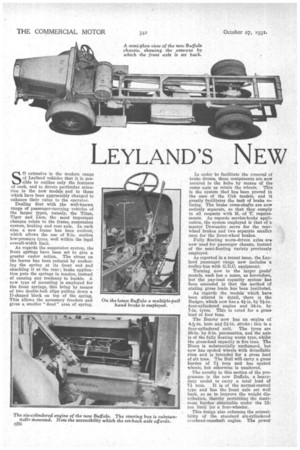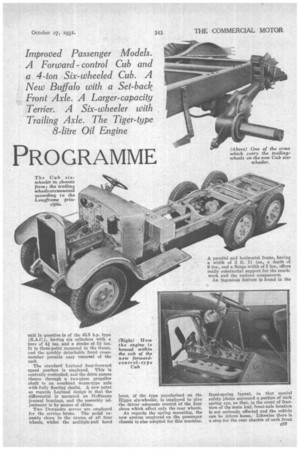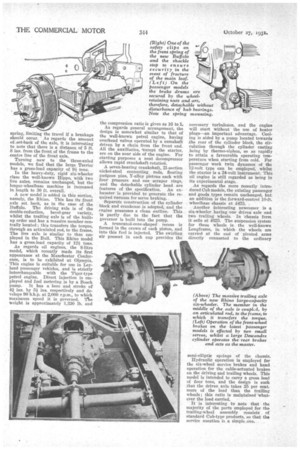LEYLAND'S NEW PROGRAMME
Page 86

Page 87

Page 88

If you've noticed an error in this article please click here to report it so we can fix it.
Improved Passenger Models.
A Forward control Cub and a 4-ton Six-wheeled Cub. A New Buffalo with a Set-back Front Axle. A Larger-capacity Terrier. A Six-wheeler with Trailing Axle. The Tiger-type 8-litre Oil Engine
S0 extensive is the modern range of Leyland vehicles that it is possible to outline only the features 44 each, and to devote particular attention to the new models and to those which have been appreciably changed to enhance their value to the operator.
Dealing first with the well-known range of passenger-carrying vehicles of the larger types, namely, the Titan, Tiger and Lion, the most important changes relate to the frame suspension system, braking and rear axle. In each case a new frame has been evolved, which allows the use of 9-in. section low-pressure tyres, well within the legal overall-width limit.
As regards the suspension system, the front springs have been set to give a greater castor action. The stress on the leaves has been reduced by anchoring the spring at its front end and shackling it at the rear ; brake application puts the springs in tension, instead of causing any tendency to buckle. A new type of mounting is employed for the front springs, this being by means of two double-bolt clips pulling down a D shaped block on top of the spring. This allows the necessary freedom and gives a. smaller " dead " area of spring.
In order to facilitate the removal of brake drums, these components are now secured to the hubs by means of the same nuts as retain the wheels. This is the system that has been proved in the case of the Cub models, and it greatly facilitates the task of brake relining. The brake cross-shafts are now entirely separate, so that they comply in all respects with M. of T. requirements. As regards service-brake application, the system employed is that of a master Dewandre servo for the rearwheel brakes and two separate smaller ones for the front-wheel brakes.
Fully floating worm-driven axles aro now used for passenger chassis, instead of the semi-floating variety previously employed.
As reported in a recent issue, the Leyland passenger range now includes a
trolley-bus with G.E.O. equipment. '
Turning now to the larger goods' models, each has a name, as heretofore, but the pay-load capacity system has teen amended in that the method of stating gross loads has been instituted.
As regards the models which have been altered in detail, there is the Badger, which now has a 4i-in. by 5i-in. four-cylindered engine and 34-in. by 7-in. tyres. This is rated for a gross load of four tons.
The Beaver now has an engine of 4;96-in. bore and 54.-in. stroke ; this is a four-cylindered unit. The tyres are 36-in. by 8-in, pneumatics, and the axle is of the fully floating worm type, whilst the gross-load capacity is five tons. The Bison is substantially unchanged, but now has spoked wheels with detadable rims and is intended for a gross load of six tons. The Bull will carry a gross burden of 7+ tons and has spoked wheels, but otherwise is unaltered.
The novelty in this section of the programme is the new Buffalo a heavyduty model to carry a total load of 7+ tons. It is of the normal-control type and has the front axle set well back, so as to improve the weight distribution, thereby permitting the maximum burden obtainable under the 12ton limit for a four-wheeler.
This design also enhances the accessibility of the standard six-cylindered erhead-camshaft engine. The power unit in question is of the 43.5 h.p. type (R.A.C.), having six cylinders with a bore of 41 ins, and a stroke of ins. It is three-point mounted in the frame, and the quickly detachable front crossmember permits easy removal of the unit.
The standard Leyland four-forward speed gearbox is employed. This is centrally controlled, and the drive passes thence through a two-piece propeller shaft to an overhead worm-type axle with fully coating shafts. A new point as regards Leyland design is that the differential is mounted on Hoffmann journal bearings, and the assembly adjustment is by means of shims.
Two Dewandre servos are employed for the service brake. The pedal expands shoes in the drums of all four wheels, whilst the multiple-pull hand
lever, of the type popularized on the Hippo six-wheeler, is employed to give the driver adequate control of the four shoes which affect only the rear wheels.
As regards the spring mounting, the new system employed on the passenger chassis is also adopted for this macitine. A parallel and horizontal frame, having a width of 2 ft. 11 ins., a depth of 9 ins., and a flange width of 3 ins., offers really substantial support for the coachwork and the various components.
An ingenious feature is found in the front-spring layout, in that special safety plates surround a portion of each spring eye, so that, in the event of fraetare of the main leaf, front-axle location is not seriously affected and the vehicle can be driven home. Likewise there is a stop for the rear shackle of each front
spring, limiting the travel if a breakage should occur. As regards the amount of set-back of the axle, it is interesting to note that there is a distance of 5 ft. 8 ins, from the front of the frame to the centre line of the front axle.
Turning now to the three-axled models, we find that the large Terrier has a gross-load capacity of tons.
In the heavy-duty, rigid six-wheeler class the well-known Hippo, with two live axles, remains unchanged, but the longer-wheelbase machine is increased in length to 30 ft. overall.
A new model is added in this section, namely, the Rhino. This has its front axle set back, as in the case of the Buffalo. The driving axle is of the double-reduction, bevel-gear variety, whilst the trailing axle is of the builtup order and has a massive member centrally located; this transfers the torque, through an articulated rod, to the frame. The live axle is similar to that employed in the Bull. This Rhino model has a gross-load capacity of 1.2i• tons.
As regards oil engines, the 8-litre model, which recently made its first appearance at the Manchester Conference, is to he exhibited at Olympia. This engine is suitable for use in Leyland passenger vehicles, and is strictly interchangeable with the Tiger-type petrol engine. Direct injection is employed and fuel metering is by a Bosch pump. It has a bore and stroke of 4g ins. by 51 ins, respectively and develops 90 b.h.p. at 2,000 r.p.m., to which maximum speed it is governed. Time weight is approximately 1,320 lb. and the compression ratio is given as 16 to 1.
As regards general arrangement, the design is somewhat similar to that of the well-known petrol engine, having overhead valves operated by a camshaft driven by a chain from the front end. All the auxiliaries, 'except the starter, are on the near side of the engine. For starting purposes a neat decompressor allows rapid crankshaft rotation.
A seven-bearing crankshaft, H-section nickel-steel connecting rods, floating gudgeon pins, Y-alloy pistons each with four pressure and one scraper rings, and the detachable cylinder head . are features of the specification. An exhauster is provided to generate the required vacuum for servo braking.
Separate construction • of the cylinder block and crankcase is adopted, and the engine possesses a clean outline. This is partly due to the fact that the governor is built into the pump.
A truncated-cone-shaped recess is formed in the crown of each piston, and into this fuel is injected. The swirling air present in each cup provides the necessary turbulence, and the engine will start without the use of heater plugs—an important advantage. Cooling is aided by a pump located towards the rear of the cylinder block, the circulation through the cylinder casting being by thermo-siphon, so as rapidly to attain a favourable operating temperature when starting from cold. For passenger work twin dynamos of the 12-volt type can be employed, whilst the starter is a 24-volt instrument. This oil engine is still regarded as being in its experimental stage.
As regards the more recently introduced Cub models, the existing passenger and goods types remain unchanged, but an addition is the forward-control 10-ft. wheelbase chassis at £475.
• Another -interesting newcomer is a six-wheeler having one driven axle and two trailing wheels. In 'chassis form it sells at £625. The suspension system for these wheels is the well-known Longframe, in which the wheels are carried at the end of pivoted arms directly connected •to the ordinary semi-elliptic springs of the chassis. Hydraulic operation is employed for the six-wheel service brakes and hand operation for the cable-actuated brakes on the driving and trailing wheels. This model is intended to carry a gross load of four tons, and the design is such that the driven axle takes 25 per cent. more of the load than the trailing wheels ; this ratio is maintained whatever the load carried.
It is interesting to note that the majority of the parts employed for the trailing-wheel assembly consists of standard Cub-type products, so that the service question is a simple one




































































































































































